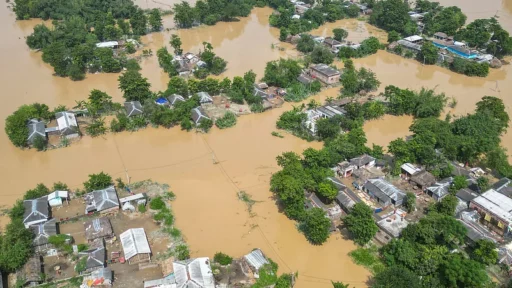
Devastation Strikes Bihar as Koshi River Floods After Burst Barrage Gates
In late September 2024, Bihar suffered one of its worst natural disasters in decades when the Koshi River, swollen by torrential rainfall across Nepal, led authorities to open all 56 gates of the Birpur Barrage on September 28. As unprecedented volumes of water released—approximately 6.61 lakh cusecs—villages across 13 Bihar districts faced catastrophic flooding.
Over 16 lakh people were impacted, infrastructure was wiped out, and agricultural fields were submerged. The disaster was widely described as the worst flood to hit Bihar in over 50 years.
Flood Timeline & Impact
-
On September 28, water from Nepal’s monsoon-swollen Koshi basin surged through barrage gates.
-
Major rivers in Bihar, including the Koshi and Ganga tributaries, breached embankments, triggering widespread inundation.
-
Districts like Supaul, Saharsa, Madhepura, Darbhanga, and Katihar were among the hardest hit.
-
Homes, roads, schools, markets, and farmland were submerged—leaving residents stranded and helpless.
Relief operations launched immediately; roads were converted into waterways, barang trains stalled, and communities became isolated amidst swirling currents.
Human Toll and Immediate Response
-
Thousands were displaced within hours.
-
Rescue teams, local government units, and NDRF squads mobilised, evacuating families via boats and setting up emergency shelters.
-
Medical aid, food kits, clean water, and sanitation facilities were rushed in.
-
Schools and public offices remained closed; transport was halted in multiple districts.
In addition to displacement, displaced families reported property loss and destruction of livelihoods just as the harvest season loomed.
Structural Causes Behind the Flood
-
Excessive Gate Release: Releasing full barrage gates released an unprecedented volume of water downstream.
-
Monsoon Overload & Poor Dam Management: Nepal’s heavy rainfall and reservoir mismanagement compounded the flow.
-
Aging Embankments: Many embankments failed, having not been upgraded or reinforced in decades.
-
Poor Floodplain Governance: Construction in flood-prone zones, and neglect of natural drainage exacerbated flooding.
Economic Losses & Agricultural Damage
-
Entire swathes of paddy, maize, sugarcane, and pulses fields were submerged.
-
At least 50,000 hectares of farmlands reported crop losses.
-
Rural markets, shops, and livestock holdings were severely hit.
-
Repairing culverts, roads, bridges, and embankments would involve costs in crores of rupees.
Why This Flood Was Exceptional
-
This was Bihar’s biggest flood in over 50 years, surpassing the 1968 historical crest.
-
The forced release of all barrage gates remains controversial—especially given flood protection guidelines.
-
Few neighbouring countries suffered similar damage, highlighting mismanagement rather than natural triggers alone.
Lessons for Climate Preparedness & Policy
-
Saltwater embankment upgrades and maintenance must be accelerated.
-
Floodwater routing approaches should be recalibrated to reduce downstream impact.
-
Planners should identify risk zones and prevent reconstruction or settlement in floodplains.
-
Real-time remote sensors and data-driven alerts must integrate with local administration.
-
Crop insurance and disaster compensation need to be bolstered for floods.
Final Takeaway
The 2024 Koshi flood was a climate-triggered crisis—made worse by outdated infrastructure, poor policy, and governance failures. While monsoons are inevitable, large-scale devastation is not. With proactive planning, smarter water governance, and resilient infrastructure, India can mitigate future disasters.
This event serves as a stark reminder: flood response must evolve from reactive rescue to preventive resilience.